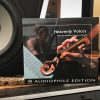
Review: AIAIAI TMA-2 Studio Wireless+
These near-zero latency, lossless, wireless headphones are ear-worms, in more ways than one.
It seems oddly Scandinavian that Danish audio design company AIAIAI should choose to ship its modular headphones with ‘some assembly required’. Within the box, each part comes enclosed in its own 100% recycled polythene envelope. This may seem frugal, but it’s a smart way to cut down on the costs, material waste, and the energy required to manufacture the packing cradles and other void-filler.
The familiarity gained during construction provides the user with an awareness of the parts that make up the whole. As you’re not just opening a box containing a complete, singular unit, you also get a sense of module-interchangeability. The build-your-own section of the AIAIAI website offers a rich but practical menu of voicings, comfort factors, and other upgrade options.
BUILD YOUR OWN
I absolutely appreciate the environmentally aware principles of the company, but this component-fluidity extends the value of these headphones well beyond a pro-earth ethic. Being this customisable ensures their relevance in a wider array of situations as they can adapt to suit specific use-cases and tastes. It’s also a refreshing departure from the ubiquity of planned-obsolescence.
Once constructed, the components of the stock TMA-2 Wireless+ headphones feel immediately substantial and comfortable. CO2-neutral Alcantara faux-suede covers the earpads. The ear-cup height mechanism is a basic design — no swivels or ergonomic folding options for bag-stowing — just a sliding ratchet to make adjustments. The simple rubbererised top-pad of the headband has been effective enough for the pair to remain on my head for long sessions with minimal discomfort. The top side of the headband reveals three raised buttons and a pin-hole aperture to illuminate the various function states and modes.
A few button-hold combos to fire up the connection between the headband and smartphone-sized transmitter and you’re off and running.
The main area of interest with these headphones is their connectivity. They can be hooked up in the traditional way, cabled via a 3.5mm TRS connector into the base of either shell. There’s 80+ hours of Bluetooth 5.0 playback, supporting AAC and SBC formats, and finally its own brand of audio streaming in Wireless+ Link mode.
LESS IS MORE
‘Wireless+’ is AIAIAI’s proprietary lossless audio transmission format. This was developed over a three-year period, in consultation with a range of artists, creators, and educators — most notably, minimal-techno futurist, Richie Hawtin. The format comes with the startling claim of having near zero-latency. And yeah, wow… After having a quick hammer on the pads of a sampler, I wasn’t able to distinguish between tethered and Wireless+ Link mode. The documentation says that they’re doing 44k/16-bit at up to 1500kbps in around 16ms. That’s pretty substantial when the nearest codec, Sony’s LDAC, has an algorithmic delay that runs at about twice that.
I do recognise that AIAIAI’s streaming technology is not a Bluetooth variant so it’s perhaps not right to directly compare, but for the sake of real-world use against comparative technologies it’s quite interesting to see the difference. Wireless+ mode provides cable-free audio over a 12 metre line-of-sight range. The denser number crunching required by the stream means that the battery in the H10 headband takes a hit, giving you 16 hours, and the X01 transmitter about twice that.
Once connected to the transmitter they offer quite captivating sonic performance. No element seems to stand out, and everything has room to breathe. This provides a calm, immersive performance, which inspires a kind of mindfulness, given you can’t help but drop your thoughts to tune in to your ears. Their uncluttered soundstage allows unfamiliar details to emerge from familiar program material. I am also hearing elements in my own recordings that had gone unnoticed during the microscopic analysis of the mixing process.
They’re complex, yet they don’t feel at all overstated or distracting, and this seems to align with the description of the S05 ‘Speaker Units’. They have ‘detailed sound’ produced by a 40mm ‘bio-diaphragm’. Mids and highs seem present but not at all swampy or brittle. While they’re certainly not about enhancing the air-down-there, the subtle bottom end never feels lost. The Alcantara pads only offer a little passive noise isolation, but if that’s a concern then a set of E02 PU-leather-covered memory-foam earpads should increase the rejection. However, these will also change the character of the sound. With this in mind, I imagine that it could be handy to keep a kit of different pad-sets to modify the sound profile and isolation as the environment requires.
NEED TO KNOW
AIAIAI TMA-2 Studio Wireless+
Closed-Back Wireless Headphones


BIOPHRAGM?
In the simplest of terms, the perfect speaker diaphragm is infinitely rigid and infinitely light. The rigidity helps to produce detailed audio program more accurately, and the low mass ensures that the detail can be reproduced efficiently. This allows for the reproduction of audio with low levels of harmonic distortion, and makes them a good proposition for studio monitoring.
So, with AIAIAI once again doing away with less-sustainable industry practices its diaphragms are actually woven from a renewable, biodegradable bacterial cellulose which grows in very lightweight, rigid strands. The result is a smooth, detailed ride, with a favourable mid-range response, clear high end definition, and a pleasant dynamic range.
I feel I’m only scratching the surface of what these headphones are able to offer, given there are three different diaphragm voicing options, five earpad types, five headbands, and eight cable types available. As such, it’s easy to imagine the case for no two pairs being — or sounding — the same. Tethered or untethered, I see them being useful in any situation — whether that be commuting, mixing or tracking in the studio, or even DJing — if you can get beyond the rigid headband.
In the words of AIAIAI, “With responsible design we minimise the risk of our products becoming obsolete.”
Using less environmentally demanding construction, materials and approaches is a good start. Allowing practical component replacement and re-voicing is a step beyond.
Add in the luxury of lag-less, lossless, wireless audio… Its products become indispensable.

























I may have gotten a bad pair, but trying to track anything with acoustic drums and/or bass guitar and they would distort like crazy, completely unusable.